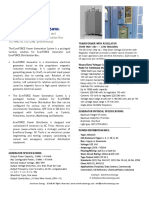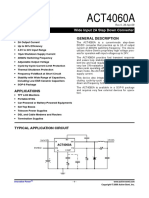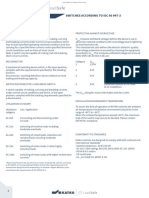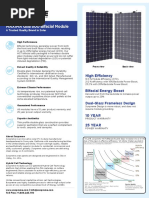Buck Boost
Buck Boost
Uploaded by
Myneni_Preetha_1271Copyright:
Available Formats
Buck Boost
Buck Boost
Uploaded by
Myneni_Preetha_1271Original Title
Copyright
Available Formats
Share this document
Did you find this document useful?
Is this content inappropriate?
Copyright:
Available Formats
Buck Boost
Buck Boost
Uploaded by
Myneni_Preetha_1271Copyright:
Available Formats
Buck-Boost – Powerformer™
0.050 to 10 KVA
Contents
Overview 9.2
Dimensional Drawings 9.9
Sept 08
Wiring Diagrams 9.10
Selection Charts
120 x 240 V – 12/24 V 60 Hz 9.8
Date
120 x 240 V – 16/32 V 60 Hz 9.8
240 x 480 V – 24/48 V 60 Hz 9.8
JE901 0809
Version
1-800-892-3755 www.jeffersonelectric.com Dry-Type Transformers 9.1
9 Buck-Boost – Powerformer™
Products
■ Single-Phase Encapsulated: 50 VA through 10 KVA*
Applications
■ For correcting voltage line drops, landscape lighting, low voltage lighting, international voltage
adaptation and motor applications
■ Note: Buck-boost transformers do not compensate for fluctuating line voltages.
Specifications
■ Encapsulated with electrical grade resin
■ Cores of high quality electrical steel
■ NEMA 3R-rated enclosures
■ 135ºC temperature rise, 180ºC insulation class or
95ºC temperature rise, 130ºC insulation class
depending on kVA size
■ Heat-cured ASA-61 gray powder coat finish
Features, Functions, Benefits
■ Slotted mounting holes for quick and easy mounting
■ Convenient wall mount design with lifting hooks above 5 KVA
■ Permanently affixed wiring diagram
Standards
■ Built in accordance with NEMA, ANSI, UL and CSA standards
*Options and Accessories
■ CE Marked units available as custom
■ Other sizes and voltages available as custom
Sept 08
Date
JE901 0809
Version
9.2 Dry-Type Transformers www.jeffersonelectric.com 1-800-892-3755
Buck-Boost – Powerformer™ 9
Jefferson Electric single-phase Buck-Boost transformers are the most economical means available
for stepping voltages up or down in many common applications. They can be used as isolating (or
insulating) transformers for transforming standard line voltages to low secondary voltages. They are
also used to buck or boost off-standard line voltages to satisfy standard load voltage requirements
when connected in an autotransformer configuration.
These transformers are designed for use on single- or three-phase circuits to supply 12/24 or
16/32 volt secondaries with 120/240 volt primary, and 24/48 volt secondaries with 240/480 volt
primary. When connected in an autotransformer configuration, these small, compact and lightweight
units will handle a large KVA load in comparison to their physical size and relative cost. When used as
isolation transformers, they have innumerable low voltage applications.
The difference between an
autotransformer and an
isolation transformer.
In an autotransformer, the input (or primary) and the output
(or secondary) are electrically connected, while in an isolation Autotransformer
transformer they are completely separated, as shown to the right.
Only a portion of the electrical energy is changed in an auto-
transformer, the remainder flowing directly between the primary
and secondary. In an isolation transformer, all the energy is
transformed. For these reasons, an autotransformer is smaller,
lighter and less costly than a comparable isolation transformer. Isolation (or Insulating)
Transformer
Solve over/under line voltage problems efficiently
and economically.
Sept 08
Electrical equipment is manufactured to operate most efficiently when the line voltage is equal to or
nearly equal to the nameplate rating of the equipment. A motor operated at a voltage substantially
Date
under its nameplate rating may run constantly on the starting windings, resulting in overheating and
possible burn-out. The same motor operated at a voltage substantially over its nameplate rating is
subject to excessive heat rise, often extending beyond the insulation temperature limits, which may
JE901 0809
eventually cause the motor to burn out.
Caution: Buck-Boost transformers will not compensate for fluctuating line voltages. They should only be used when line
Version
voltage is relatively constant.
1-800-892-3755 www.jeffersonelectric.com Dry-Type Transformers 9.3
9 Buck-Boost – Powerformer™
How to Use the Buck-Boost Rapid Selector Charts:
You will need the following information:
Line voltage:
This can be determined by measuring the supply line voltage with a voltmeter.
Load voltage:
The voltage at which your equipment was designed to operate. Usually listed on the equipment
nameplate.
Load KVA or load amps:
One of these will usually be listed on the nameplate. You do not need both.
Supply line and equipment frequencies:
This will be either 50 or 60 cycles. The supply line frequency must be the same as the frequency of
the equipment to be operated.
Supply line and equipment phase:
Either single-phase or three-phase. The line phase must be the same as the equipment.
The type of electrical configuration:
Delta or Wye.
Follow These Five Easy Steps:
1. Find the appropriate single-phase, three-phase
delta or three-phase wye table. Example:
(Assume the following information)
2. Read down the voltage column and find the
nearest ratio of required load voltage to line voltage 1. A reasonably constant line voltage of
for the application desired. (High and low voltage 440 volts.
may be either input or output voltage depending on 2. A required equipment voltage of 480 volts.
the circumstances.) 3. 26.0 KVA load capacity needed.
3. Reading horizontally across the line beginning with 4. Single-phase line and equipment.
your application voltage ratio, locate in one of the In the voltage column, 437 is closest to our line
Sept 08
KVA columns a KVA capacity equal to or larger voltage of 440. The 480 high voltage meets our
than your load requirement. requirements exactly.
4. Note the two digit number at the top of the KVA Reading horizontally across this line, find 30.0
KVA, the closest larger KVA to our required 26.0. Date
column listing the KVA capacity you require.
Going to the very top of this column, take the
5. In the catalog number column, add these two two digit number, 81, and add it on the end of
JE901 0809
digits to the catalog number next to the voltage the catalog number on the same line as our
ratio you found in step one. high/low voltage. The catalog number 416-14,
with 81 added on the end, is 416-1481.
Version
The listings here do not cover all the
possible applications of these versatile
transformers. Please call for advice or a
quotation on special applications.
9.4 Dry-Type Transformers www.jeffersonelectric.com 1-800-892-3755
Buck-Boost – Powerformer™ 9
Single-Phase KVA Capacity of Encapsulated Powerformers™
Maximum load capabilities
01 11 21 31 41 51 61 71 81 91
Low High Catalog Load .100 .150 .250 .500 .750 1.0 1.5 2.0 3.0 5.0 Wiring
Voltage (LV) Voltage (HV) Number Required* KVA KVA KVA KVA KVA KVA KVA KVA KVA KVA Diagram
KVA .37 .56 .94 1.8 2.8 3.7 5.6 7.5 11.2 18.8
95 120 416-12 AMPS 3.95 5.93 9.89 19.7 29.6 39.5 59.3 79.1 118 197 2
KVA .50 .75 1.25 2.50 3.7 5.0 7.5 10.0 15.0 25.0
100 120 416-11 AMPS 5.0 7.5 12.5 25.0 37.0 50.0 75.0 100 150 250 2
KVA .75 1.12 1.87 3.7 5.6 7.5 11.2 15.0 22.5 37.0
106 120 416-12 AMPS 7.07 10.5 17.6 34.9 52.8 70.7 105 141 212 349 1
KVA 1.00 1.50 2.50 5.0 7.5 10.0 15.0 20.0 30.0 50.0
109 120 416-11 1
AMPS 9.17 13.7 22.9 45.8 68.8 91.7 137 183 275 458
KVA 1.10 1.65 2.75 5.5 8.2 11.0 16.5 22.0 33.0 55.0
120 132 416-11 AMPS 9.17 13.7 22.9 45.8 68.8 91.7 137 183 275 458 1
KVA .85 1.27 2.12 4.2 6.3 8.5 12.7 17.0 25.5 42.0
120 136 416-12 AMPS 7.08 10.5 17.6 35.0 52.5 70.8 105 141 212 350 1
KVA .60 .90 1.50 3.0 4.5 6.0 9.0 12.0 18.0 30.0
120 144 416-11 AMPS 5.0 7.5 12.5 25.0 37.5 50.0 75.0 100 150 250 2
KVA .47 .71 1.18 2.3 3.5 4.7 7.1 9.5 14.2 23.0
120 152 416-12 AMPS 3.91 5.91 9.83 19.1 29.1 39.1 59.1 79.1 118 191 2
KVA .50 .75 1.25 2.5 3.7 5.0 7.5 10.0 15.0 25.0
200 240 416-14 AMPS 2.50 3.75 6.25 12.5 18.7 25.0 37.5 50.0 75.0 125 2
KVA .73 1.10 1.84 3.6 5.5 7.3 11.0 14.7 22.1 36.8
208 236 416-12 AMPS 3.53 5.28 8.82 17.4 26.4 35.3 52.8 70.7 106 174 4
KVA .75 1.12 1.87 3.7 5.6 7.5 11.2 15.0 22.5 37.0
212 240 416-12 AMPS 3.53 5.28 8.82 17.4 26.4 35.3 52.8 70.7 106 174 4
KVA .95 1.4 2.3 4.7 7.1 9.5 14.3 19.0 28.6 47.6
208 230 416-11 AMPS 4.58 6.88 11.4 22.9 34.4 45.8 68.8 91.7 137 229 4
KVA 1.00 1.5 2.5 5.0 7.5 10.0 15.0 20.0 30.0 50.0
218 240 416-11 AMPS 4.58 6.88 11.4 22.9 34.4 45.8 68.8 91.7 137 229 4
KVA 1.5 2.25 3.75 7.5 11.2 15.0 22.5 30.0 45.0 75.0
225 240 416-12 AMPS 6.66 10.0 16.6 33.3 49.7 66.6 100 133 200 333 3
KVA .57 .86 1.43 2.8 4.3 5.7 8.6 11.5 17.2 28.7
230 276 416-14 AMPS 2.50 3.75 6.25 12.5 18.7 25.0 37.5 45.0 75.0 124 2
KVA 2.1 3.15 5.25 10.5 15.7 21.0 31.5 42.0 63.0 105
240 252 416-11 AMPS 8.75 13.1 21.8 43.7 65.4 87.5 131 175 262 437 3
KVA 1.1 1.65 2.75 5.5 8.2 11.0 16.5 22.0 33.0 55.0
240 264 416-11 AMPS 4.58 6.87 11.4 22.9 34.1 45.8 68.7 91.6 137 229 4
KVA .85 1.27 2.12 4.2 6.3 8.5 12.7 17.0 25.5 42.0
240 272 416-12 AMPS 3.54 5.29 8.83 17.5 26.2 35.4 52.9 70.8 106 175 4
KVA .60 .90 1.50 3.0 4.5 6.0 9.0 12.0 18.0 30.0
240 288 416-14 AMPS 2.5 3.75 6.25 12.5 18.7 25.0 37.5 50.0 75.0 125 2
KVA 1.00 1.50 2.50 5.0 7.5 10.0 15.0 20.0 30.0 50.0
437 480 416-14 AMPS 2.28 3.43 5.72 11.4 17.1 22.8 34.3 45.7 68.6 114 4
KVA 2.0 3.0 5.0 10.0 15.0 20.0 30.0 40.0 60.0 100
457 480 416-14 AMPS 4.37 6.56 10.9 21.8 32.8 43.7 65.6 87.5 131 218 3
KVA 2.1 3.15 5.25 10.5 15.7 21.0 31.5 42.0 63.0 105
480 504 416-14 AMPS 4.37 6.56 10.9 21.8 32.8 43.7 65.6 87.5 131 218 3
KVA 1.1 1.65 2.75 5.5 8.2 11.0 16.5 22.0 33.0 55.0
480 528 416-14 4
Sept 08
AMPS 2.29 3.43 5.72 11.4 17.0 22.9 34.3 45.8 68.7 114
* Load required is calculated based on the low voltage as the load.
Buck-Boost Wiring Diagram 1 Buck-Boost Wiring Diagram 2
Date
JE901 0809
Buck-Boost Wiring Diagram 3 Buck-Boost Wiring Diagram 4
Version
1-800-892-3755 www.jeffersonelectric.com Dry-Type Transformers 9.5
9 Buck-Boost – Powerformer™
Three-Phase KVA Capacity of Encapsulated Powerformers™ Connected in Open-Delta
Maximum load capabilities requiring two Powerformers
01 11 21 31 41 51 61 71 81 91
Low High Catalog Load .100 .150 .250 .500 .750 1.0 1.5 2.0 3.0 5.0 Wiring
Voltage (LV) Voltage (HV) Number Required* KVA KVA KVA KVA KVA KVA KVA KVA KVA KVA Diagram
KVA 0.86 1.29 2.1 4.3 6.4 8.6 12.9 17.2 25.0 43.0
200 240 416-14xx Amperes 2.1 3.1 5.1 10.3 15.4 20.7 31.0 41.4 60.1 103.4 10
KVA 1.27 1.91 3.1 6.3 9.5 12.7 19.1 25.5 38.2 63.7
208 236 416-12xx Amperes 3.1 4.7 7.6 15.4 23.2 31.1 46.7 62.4 93.4 155.8 12
KVA 1.29 1.94 3.2 6.4 9.7 12.9 19.4 25.8 38.0 64.0
212 240 416-12xx Amperes 3.1 4.7 7.7 15.4 23.3 31.0 46.7 62.1 91.4 154.0 12
KVA 1.65 2.47 4.1 8.2 12.3 16.5 24.7 33.0 49.5 82.5
208 230 416-11xx Amperes 4.1 6. 2 10.3 20.6 30.9 41.4 62.0 82.8 124.3 207.1 12
KVA 1.73 2.59 4.3 8.6 12.9 17.3 25.9 34.6 51.0 86.0
218 240 416-11xx Amperes 4.2 6.2 10.3 20.7 31.0 41.6 62.3 83.2 122.7 206.9 12
KVA 2.59 3.89 6.4 12.9 19.4 25.9 38.9 51.9 77.0 129
225 240 416-12xx Amperes 6.2 9.4 15.4 31.0 46.7 62.3 93.6 124.8 185.2 310.3 11
KVA 3.46 5.18 8.6 17.3 25.9 34.6 51.8 69.2 103 173
229 240 416-11xx Amperes 8.3 12.5 20.7 41.6 62.3 83.2 124.6 166.5 247.8 416.2 11
KVA 1.81 2.72 4.5 9.0 13.6 18.1 27.2 36.3 54.0 90.0
230 253 416-14xx Amperes 4.1 6.2 10.3 20.5 31.0 41.3 62.1 82.8 123.2 205.4 9
KVA 0.99 1.49 2.4 4.9 7.4 9.9 14.9 19.9 29.0 49.0
230 276 416-14xx Amperes 2.1 3.1 5.0 10.2 15.5 20.7 31.2 41.6 60.7 102.5 10
KVA 3.64 5.47 9.1 18.2 27.2 36.4 54.7 72.8 109 182
240 252 416-11xx Amperes 8.3 12.5 20.8 41.7 62.3 83.4 125.3 166.8 249.7 417.0 11
KVA 1.9 2.86 4.7 9.5 14.2 19.0 28.6 38.1 57.0 95.0
240 264 416-11xx Amperes 4.2 6.3 10.3 20.8 31.1 41.6 62.5 83.3 124.7 207.8 12
KVA 1.47 2.2 3.6 7.3 11.0 14.7 22.0 29.4 44.1 73.6
240 272 416-12xx Amperes 3.1 4.7 7.6 15.5 23.3 31.2 46.7 62.4 93.6 156.2 12
KVA 1.03 1.55 2.5 5.1 7.7 10.3 15.5 20.7 31.0 51.0
240 288 416-14xx Amperes 2.1 3.1 5.0 10.2 15.4 20.6 31.1 41.5 62.1 102.2 10
KVA 1.73 2.59 4.3 8.6 12.9 17.3 25.9 34.6 51.0 86.0
437 480 416-14xx Amperes 2.1 3.1 5.2 10.3 15.5 20.8 31.2 41.6 61.3 103.4 12
KVA 3.46 5.18 8.6 17.3 25.9 34.6 51.8 69.2 103 173
457 480 416-14xx Amperes 4.2 6.2 10.3 20.8 31.2 41.6 62.3 83.2 123.9 208.1 11
KVA 3.64 5.47 9.1 18.2 27.2 36.4 54.7 72.8 109 183
480 504 416-14xx Amperes 4.2 6.3 10.4 20.8 31.2 41.7 62.7 83.4 124.9 209.6 11
KVA 1.9 2.86 4.7 9.5 14.2 19.0 28.6 38.1 57.0 95.0
480 528 416-14xx Amperes 2.1 3.1 5.1 10.4 15.5 20.8 31.3 41.7 62.3 103.9 12
* Load required is calculated based on the low voltage as the load.
Buck-Boost Wiring Diagram 9 Buck-Boost Wiring Diagram 10
Sept 08
Date
Buck-Boost Wiring Diagram 11 Buck-Boost Wiring Diagram 12
JE901 0809
Version
9.6 Dry-Type Transformers www.jeffersonelectric.com 1-800-892-3755
Buck-Boost – Powerformer™ 9
Three-Phase KVA Capacity of Encapsulated Powerformers™ Connected in Wye
Maximum load capabilities requiring three Powerformers
01 11 21 31 41 51 61 71 81 91
Low High Catalog Load .100 .150 .250 .500 .750 1.0 1.5 2.0 3.0 5.0 Wiring
Voltage (LV) Voltage (HV) Number Required* KVA KVA KVA KVA KVA KVA KVA KVA KVA KVA Diagram
KVA 1.1 1.7 2.8 5.6 8.4 11.2 16.8 22.0 34.0 56.0
164 208 416-12 AMPS 3.89 5.89 9.79 18.9 29.4 38.9 58.9 78.9 117 197 6
KVA 1.5 2.2 3.7 7.5 11.2 15.0 22.5 30.0 45.0 75.0
173 208 416-11 AMPS 5.0 7.5 12.5 25.0 37.0 50.0 75.0 100 150 250 6
KVA 2.2 3.3 5.6 11.2 16.8 22.5 33.7 45.0 67.0 112
183 208 416-12 AMPS 7.07 10.5 17.6 34.9 52.8 70.7 105 141 212 354 5
KVA 3.0 4.5 7.5 15.0 22.5 30.0 45.0 60.0 90.0 150
189 208 416-11 5
AMPS 9.17 13.7 22.9 45.8 68.8 91.7 137 183 275 458
KVA 3.3 4.9 8.2 16.5 24.7 33.0 49.5 66.0 99.0 165
208 229 416-11 AMPS 9.17 13.7 22.9 45.8 68.8 91.7 137 183 275 458 5
KVA 2.5 3.8 6.3 12.7 19.1 25.5 38.2 51.0 76.5 127
208 235 416-12 AMPS 7.08 10.5 17.6 35.0 52.5 70.8 105 141 212 350 5
KVA 1.8 2.7 4.5 9.0 13.5 18.0 27.0 36.0 54.0 90.0
208 249 416-11 AMPS 5.0 7.5 12.5 25.0 37.5 50.0 75.0 100 150 250 6
KVA 1.4 2.1 3.5 7.1 10.6 14.2 21.4 28.0 42.0 71.0
208 263 416-12 AMPS 3.91 5.91 9.83 19.1 29.1 39.1 59.1 79.1 118 191 6
KVA 1.5 2.2 3.7 7.5 11.2 15.0 22.5 30.0 45.0 75.0
346 416 416-14 AMPS 2.5 3.75 6.25 12.5 18.5 25.0 37.5 50.0 75.0 125 6
KVA 2.2 3.3 5.6 11.2 16.8 22.5 33.7 45.0 67.0 112
367 416 416-12 AMPS 3.53 5.28 8.82 17.4 26.4 35.3 52.8 70.7 106 174 8
KVA 3.0 4.5 7.5 15.0 22.5 30.0 45.0 60.0 90.0 150
378 416 416-11 AMPS 4.58 6.88 11.4 22.9 34.4 45.8 68.8 91.7 137 229 8
KVA 4.5 6.7 11.2 22.5 33.7 45.0 67.5 90.0 135 225
390 416 416-12 AMPS 6.66 10.0 16.6 33.3 49.7 66.6 100 133 200 333 7
KVA 6.0 9.0 15.0 30.0 45.0 60.0 90.0 120 180 300
397 416 416-11 AMPS 8.73 13.1 21.8 43.6 65.5 87.3 131 174 262 436 7
KVA 3.1 4.7 7.8 15.7 23.6 31.5 47.2 63.0 94.0 157
398 438 416-14 AMPS 4.56 6.82 11.3 22.6 33.9 45.6 68.2 91.3 136 229 5
KVA 1.7 2.5 4.3 8.6 12.9 17.2 25.9 34.0 51.0 86.0
398 478 416-14 AMPS 2.50 3.75 6.25 12.5 18.7 25.0 37.5 50.0 75.0 125 6
sKVA 6.3 9.4 15.7 31.5 47.2 63.0 94.5 126 189 315
416 437 416-11 AMPS 8.75 13.1 21.8 43.7 65.4 87.5 131 175 262 437 7
KVA 4.8 7.2 12.0 24.0 36.0 48.0 72.0 96.0 144 240
416 443 416-12 AMPS 6.66 10.0 16.6 33.3 50.0 66.6 100 133 200 333 7
KVA 3.3 4.9 8.2 16.5 24.7 33.0 49.5 66.0 99.0 165
416 457 416-11 AMPS 4.58 6.87 11.4 22.9 34.1 45.8 68.7 91.6 137 229 8
KVA 2.5 3.8 6.3 12.7 19.1 25.5 38.2 51.0 76.5 127
416 471 416-12 AMPS 3.54 5.29 8.83 17.5 26.2 35.4 52.9 70.8 106 175 8
KVA 1.8 2.7 4.5 9.0 13.5 18.0 27.0 36.0 54.0 90.0
416 498 416-14 AMPS 2.5 3.75 6.25 12.5 18.7 25.0 37.5 50.0 75.0 125 6
* Load required is calculated based on the low voltage as the load.
Buck-Boost Wiring Diagram 5 Buck-Boost Wiring Diagram 6
Sept 08
Date
JE901 0809
Buck-Boost Wiring Diagram 7 Buck-Boost Wiring Diagram 8
Version
1-800-892-3755 www.jeffersonelectric.com Dry-Type Transformers 9.7
9 Buck-Boost – Powerformer™
Single-Phase - 600V Class
.050 – 1 KVA: 130°C Insulation Class • 1.5 – 10 KVA: 180°C Insulation Class
Catalog Height A Width B Depth C Wiring Est. Ship
KVA Number Fig. (in.) (in.) (in.) Diagram Wgt. (lbs.)
120 x 240 V – 12/24 V 60 Hz
.050 416-1100-000 2 8.03 3.31 3.08 S240B 4.4
.100 416-1101-000 2 8.03 3.31 3.08 S240B 4.8
.150 416-1111-000 2 8.03 3.31 3.08 S240B 5.6
.250 416-1121-000 2 8.03 3.31 3.08 S240B 6.7
.500 416-1131-000 2 10.19 5.06 4.59 S240B 15.0
.750 416-1141-000 2 10.19 5.06 4.59 S240B 17.0
1 416-1151-000 2 10.19 5.06 4.59 S240B 19.5
1.5 416-1161-000 3 12.50 6.69 5.34 S240B 35.0
2 416-1171-000 3 12.50 6.69 5.34 S240B 41.2
3 416-1181-000 3 14.56 7.56 7.15 S240B 48.0
5 416-1191-000 3 14.56 7.56 7.15 S240B 90.5
7.5 416-2101-000 4 16.12 13.50 8.55 S240B 130.0
10 416-2111-000 4 16.12 13.50 8.55 S240B 158.0
120 x 240 V – 16/32 V 60 Hz
.100 416-1201-000 2 8.03 3.31 3.08 S240C 4.8
.150 416-1211-000 2 8.03 3.31 3.08 S240C 5.6
.250 416-1221-000 2 8.03 3.31 3.08 S240C 6.7
.500 416-1231-000 2 10.19 5.06 4.59 S240C 15.0
.750 416-1241-000 2 10.19 5.06 4.59 S240C 17.0
1 416-1251-000 2 10.19 5.06 4.59 S240C 19.5
S240C
1.5 416-1261-000 3 12.50 6.69 5.34 S240C 35.0
2 416-1271-000 3 12.50 6.69 5.34 S240C 41.2
3 416-1281-000 3 14.56 7.56 7.15 S240C 48.0
5 416-1291-000 3 14.56 7.56 7.15 S240C 90.5
7.5 416-2201-000 4 16.12 13.50 8.55 S240C 130.0
10 416-2211-000 4 16.12 13.50 8.55 S240C 158.0
240 x 480 V – 24/48 Vs 60 Hz
.100 416-1401-000 2 8.03 3.31 3.08 4.8
.150 416-1411-000 2 8.03 3.31 3.08 S240E 5.6
.250 416-1421-000 2 8.03 3.31 3.08 S240E 6.7
.500 416-1431-000 2 10.19 5.06 4.59 S240E 15.0
.750 416-1441-000 2 10.19 5.06 4.59 S240E 17.0
1 416-1451-000 2 10.19 5.06 4.59 S480E 19.5
S480E
1.5 416-1461-000 3 12.50 6.69 5.34 S240E 35.0
2 416-1471-000 3 12.50 6.69 5.34 S240E 41.2
3 416-1481-000 3 14.56 7.56 7.15 S240E 48.0
5 416-1491-000 3 14.56 7.56 7.15 S240E 90.5
7.5 416-2401-000 4 16.12 13.50 8.55 S240E 130.0
Feb 09
10 416-2411-000 4 16.12 13.50 8.55 S240E 158.0
Note: Housing dimensions subject to change without notice. Contact factory where dimension verification is critical. Date
®
LISTED
JE901 0809
Version
9.8 Dry-Type Transformers www.jeffersonelectric.com 1-800-892-3755
Buck-Boost – Powerformer™ 9
Figure 2 Figure 3
B C B C
A A
Figure 4
B C
Sept 08
A
Date
JE901 0809
Version
1-800-892-3755 www.jeffersonelectric.com Dry-Type Transformers 9.9
9 Buck-Boost – Powerformer™
S240B Wiring Diagram & Connections* S240C Wiring Diagram & Connections*
Wiring Diagram Wiring Diagram
Primary: 120 X 240 Primary: 120 X 240
Secondary: 12/24 Secondary: 16/32
Connections Connections
Primary Primary Lines Primary Primary Lines
Volts Interconnect Connect To Volts Interconnect Connect To
240 H2 to H3 H1-H4 240 H2 to H3 H1-H4
120 H1 to H3 H1-H4 120 H1 to H3 H1-H4
H2 to H4 H2 to H4
Sec. Secondary Lines Sec. Secondary Lines
Volts Interconnect Connect To Volts Interconnect Connect To
24 X2 to X3 X1-X4 32 X2 to X3 X1-X4
12 X1 to X3 X1-X4 16 X1 to X3 X1-X4
X2 to X4 X2 to X4
S480E Wiring Diagram & Connections*
Wiring Diagram
Primary: 240 X 480
Secondary: 24/48
Connections
Primary Primary Lines
Volts Interconnect Connect To
480 H2 to H3 H1-H4
240 H1 to H3 H1-H4
Sept 08
H2 to H4
Sec. Secondary Lines
Volts Interconnect Connect To
48 X2 to X3 X1-X4
24 X1 to X3 X1-X4 Date
X2 to X4
JE901 0809
Version
NOTE: Electrostatic shields are optionally available and not shown in all wiring diagrams.
9.10 Dry-Type Transformers www.jeffersonelectric.com 1-800-892-3755
You might also like
- Centrilift ESP Equipment Catalog PDFDocument177 pagesCentrilift ESP Equipment Catalog PDFHugo Llanos67% (3)
- Transformer Workshops Training Manual PDFDocument16 pagesTransformer Workshops Training Manual PDFBasil BaartmanNo ratings yet
- Lincoln Manual-Part Book VANTAGE 500 11467 PDFDocument76 pagesLincoln Manual-Part Book VANTAGE 500 11467 PDFMauricio Garcia100% (3)
- MTG 5MW Technical Specifications EFE 10292016Document1 pageMTG 5MW Technical Specifications EFE 10292016Anonymous wze4zUNo ratings yet
- Ingersoll Rand-Vibratory Pump AssemblyDocument8 pagesIngersoll Rand-Vibratory Pump AssemblyMohamed ZakiNo ratings yet
- Omo Furniture Designer Series - Holiday Showroom Gatherings - SaleDocument79 pagesOmo Furniture Designer Series - Holiday Showroom Gatherings - Salemrk_rlndNo ratings yet
- Catalog Solahd Buck Boost Transformers en Us 164082Document23 pagesCatalog Solahd Buck Boost Transformers en Us 164082Saifuddin SidikiNo ratings yet
- TRAFOS ELEVADORES-BuckBoostDocument8 pagesTRAFOS ELEVADORES-BuckBoostLudvin BatzibalNo ratings yet
- Buck Boost IN7900Document12 pagesBuck Boost IN7900info su-teknik.comNo ratings yet
- Transformer Basics Chapter 4Document4 pagesTransformer Basics Chapter 4Fahad AlamNo ratings yet
- 62 Low Voltage TransformersDocument36 pages62 Low Voltage TransformersBob Mitzel NavarreteNo ratings yet
- Xformer Whitepaper 2Document4 pagesXformer Whitepaper 2Mahmoud MoezNo ratings yet
- Catalogo General ACMEDocument244 pagesCatalogo General ACMEroyvindasNo ratings yet
- Transformer Questions & Answers: Dry-Type Distribution Transformers Dry-Type Distribution TransformersDocument9 pagesTransformer Questions & Answers: Dry-Type Distribution Transformers Dry-Type Distribution TransformerssotodolNo ratings yet
- Buck Boost IN7900Document12 pagesBuck Boost IN7900Adam StroufNo ratings yet
- Transformer Questions & Answers: Dry-Type Distribution Transformers Dry-Type Distribution TransformersDocument9 pagesTransformer Questions & Answers: Dry-Type Distribution Transformers Dry-Type Distribution TransformersNayan MandalNo ratings yet
- A Guide On Load Flow Analysis Using ETAPDocument20 pagesA Guide On Load Flow Analysis Using ETAPMalik EltayiebNo ratings yet
- Power Productsbro Dry Type Distribution Transformers CatalogDocument26 pagesPower Productsbro Dry Type Distribution Transformers Catalogmageziaziizi825No ratings yet
- BasicsDocument26 pagesBasicsRob100% (1)
- SF 17 Sect 08 ALL WebDocument28 pagesSF 17 Sect 08 ALL WeboscarNo ratings yet
- MultiPlus Generator FAQ (Victron Energy)Document6 pagesMultiPlus Generator FAQ (Victron Energy)georgesNo ratings yet
- AutotransformerDocument13 pagesAutotransformerkclarksidlaoNo ratings yet
- Unit4 Transformer SelectionDocument2 pagesUnit4 Transformer SelectionMulugeta AbrhaNo ratings yet
- Duct o BarDocument12 pagesDuct o BarCristhian RamirezNo ratings yet
- Variable Transformers-Prod - Design & Engineer - Data-StacoDocument7 pagesVariable Transformers-Prod - Design & Engineer - Data-StacoAirton José FloresNo ratings yet
- Autotransformer and Variable Auto Transformer PDFDocument6 pagesAutotransformer and Variable Auto Transformer PDFaesthetepkNo ratings yet
- ACT4060ADocument11 pagesACT4060ASanjeev GuptaNo ratings yet
- Autotransformer and Variable Auto TransformerDocument9 pagesAutotransformer and Variable Auto Transformerzezo478No ratings yet
- Additional InformationDocument18 pagesAdditional InformationLatif Ismail ShaikhNo ratings yet
- Lab Assingment Name: Umar Rahman Reg Nos: Fa18-Epe-015 Subject: Electric Machine Submitted T0: Sir Ali Muhammad DATE 4/10/2020Document13 pagesLab Assingment Name: Umar Rahman Reg Nos: Fa18-Epe-015 Subject: Electric Machine Submitted T0: Sir Ali Muhammad DATE 4/10/2020Maooz JanNo ratings yet
- Agn102 BDocument21 pagesAgn102 Bariwibowo100% (1)
- InvertersDocument30 pagesInvertersterryhoNo ratings yet
- Apfc PanelDocument7 pagesApfc PanelChander MohanNo ratings yet
- A Guide On Load Flow Analysis Using ETAPDocument19 pagesA Guide On Load Flow Analysis Using ETAPReza Maulana MirazaNo ratings yet
- LEC # 08 Distribution System Voltage RegulationDocument61 pagesLEC # 08 Distribution System Voltage RegulationSaddam jatt786No ratings yet
- Cne Micro ProjectDocument7 pagesCne Micro Projectjadhavayush590No ratings yet
- Abb Shunt ReactorDocument4 pagesAbb Shunt ReactorMuthu KumaranNo ratings yet
- Autotransformer BasicsDocument6 pagesAutotransformer BasicsWaseem KambohNo ratings yet
- The AutotransformerDocument7 pagesThe AutotransformerJohn Brix BalisterosNo ratings yet
- Transformer Question BankDocument5 pagesTransformer Question Bankrinijain4450% (2)
- Transformer Selection and CalculationDocument12 pagesTransformer Selection and Calculationjbebin0% (1)
- Qustions 1Document4 pagesQustions 1Harpreet SinghNo ratings yet
- Methode Test TransformerDocument4 pagesMethode Test TransformerRoni EnjelaniNo ratings yet
- Joslyn Hi-Voltage Capacitor and Reactor Switches Offer The Longest Maintenance-Free Life in The IndustryDocument34 pagesJoslyn Hi-Voltage Capacitor and Reactor Switches Offer The Longest Maintenance-Free Life in The IndustryJuliano MenezesNo ratings yet
- Compact Substation-CataloqueDocument6 pagesCompact Substation-Cataloquesaurav.dey.ranchiNo ratings yet
- Automatic Power Factor CorrectionDocument14 pagesAutomatic Power Factor CorrectionlearningboxNo ratings yet
- AcmedistributionxfmrDocument5 pagesAcmedistributionxfmrrodrigordlc7No ratings yet
- Ps Weidmuller Catalogue Eng TdsDocument24 pagesPs Weidmuller Catalogue Eng Tdsparas99No ratings yet
- Capacitors - CooperDocument4 pagesCapacitors - Cooperشہزاد حفیظNo ratings yet
- Transformer GuideDocument14 pagesTransformer GuideJoseph RoggersNo ratings yet
- Generator Operation Curve ExplainDocument10 pagesGenerator Operation Curve ExplainThar LayNo ratings yet
- KATKO Load Break and Changeover Switches - Rating - TablesDocument4 pagesKATKO Load Break and Changeover Switches - Rating - TablesVildanNo ratings yet
- Transformer Handbook From Testing and Analysis To Maintenance Case StudiesDocument125 pagesTransformer Handbook From Testing and Analysis To Maintenance Case StudiesRajkumar P. RautNo ratings yet
- Current Transformer, Potential Transformer, LTCT, Low Tension CT, Combined CTPT Unit, Metering Unit, Metering Cubicle, Resin Cast CT, Cast Resin CT, Cast Resin PT, RVT, Residual Voltatge TransformerDocument12 pagesCurrent Transformer, Potential Transformer, LTCT, Low Tension CT, Combined CTPT Unit, Metering Unit, Metering Cubicle, Resin Cast CT, Cast Resin CT, Cast Resin PT, RVT, Residual Voltatge TransformerSharafatNo ratings yet
- APC Step-Down Transformer: User Manual EnglishDocument10 pagesAPC Step-Down Transformer: User Manual EnglishCaja FuegoNo ratings yet
- KATKO-Enclosed-switches (Iberdrola) - IGMDocument6 pagesKATKO-Enclosed-switches (Iberdrola) - IGMLidia SanchezNo ratings yet
- Basic Regulator CircuitsDocument7 pagesBasic Regulator CircuitskgirisNo ratings yet
- Parallel Transformer Different ConditionsDocument9 pagesParallel Transformer Different ConditionsRohini DesaiNo ratings yet
- HP134 Pg88 FreitasDocument7 pagesHP134 Pg88 FreitasduleNo ratings yet
- ALD8100 ALD9100 FamilyDocument17 pagesALD8100 ALD9100 Familyckfly.3012No ratings yet
- Power Inverter Prowatt TM 250 12V 24VDocument25 pagesPower Inverter Prowatt TM 250 12V 24VpevalpevalNo ratings yet
- Back To Transformer UniversityDocument27 pagesBack To Transformer Universityregistracijus100% (1)
- Multilevel Converters For Large Electric DrivesDocument9 pagesMultilevel Converters For Large Electric DrivesAndresCaguaNo ratings yet
- Reference Guide To Useful Electronic Circuits And Circuit Design Techniques - Part 1From EverandReference Guide To Useful Electronic Circuits And Circuit Design Techniques - Part 1Rating: 2.5 out of 5 stars2.5/5 (3)
- Brochures w-NEXT3Document16 pagesBrochures w-NEXT3AGUNG SURYO ADI NUGROHONo ratings yet
- Ferno ScoopDocument2 pagesFerno ScoopConrad WaluddeNo ratings yet
- Utilization of Electrical Energy: Chapter 2: Electric Drives L-2-4Document26 pagesUtilization of Electrical Energy: Chapter 2: Electric Drives L-2-4Frozen BoyNo ratings yet
- Computer QuestionDocument22 pagesComputer QuestionTareqNo ratings yet
- Discover 125 UG With CBS BSIV SPC 2021 - 2022Document84 pagesDiscover 125 UG With CBS BSIV SPC 2021 - 2022gmcontablestaff23masNo ratings yet
- Worcester Central Heating ControllerDocument20 pagesWorcester Central Heating ControllerAndōNo ratings yet
- Three Phase Induction Motor 93138541001Document63 pagesThree Phase Induction Motor 93138541001Mce RegNo ratings yet
- BL2.0 Mechanical Diaphragm Price ListDocument1 pageBL2.0 Mechanical Diaphragm Price Listarijit mukhkerjeeNo ratings yet
- Allinone Manual GBDocument1 pageAllinone Manual GBvincef28No ratings yet
- Mobile: 0755/0715 912 366: Rashid AbdalahmanDocument44 pagesMobile: 0755/0715 912 366: Rashid Abdalahmanpaco kazunguNo ratings yet
- Maxima GXB 500w Bifacial Rev 1Document2 pagesMaxima GXB 500w Bifacial Rev 1craoposzNo ratings yet
- Grade 10 Physics Handout Unit 5Document21 pagesGrade 10 Physics Handout Unit 5Milkias BerhanuNo ratings yet
- TVS Ntorq Parts Catalogue BS 4Document57 pagesTVS Ntorq Parts Catalogue BS 4Sateesh Patil100% (2)
- Auto Trans Diagnosis (F4A21, F4A22, F4A23)Document18 pagesAuto Trans Diagnosis (F4A21, F4A22, F4A23)itglitz71% (7)
- PFTL99720 0edDocument6 pagesPFTL99720 0edCross GarciaNo ratings yet
- INIC-1608 Product BriefDocument2 pagesINIC-1608 Product Briefgreenelephant150No ratings yet
- "DGTP": Panel Digital Weight Transmitter/Indicator: Industrial Weighing and Dosage Systems MakingDocument4 pages"DGTP": Panel Digital Weight Transmitter/Indicator: Industrial Weighing and Dosage Systems MakingElastika TeknikaNo ratings yet
- Stretch Face Mask Pattern and InstructionsDocument10 pagesStretch Face Mask Pattern and InstructionsKate GeoNo ratings yet
- EnerVista 469 Setup Active ScreDocument5 pagesEnerVista 469 Setup Active ScreJosue CardosoNo ratings yet
- 0991manual Servicio Monorail HCDocument26 pages0991manual Servicio Monorail HCNorberto MartinezNo ratings yet
- Zilift Torque Converter IIDocument2 pagesZilift Torque Converter IIChrisitian UribeNo ratings yet
- gn125f PDFDocument148 pagesgn125f PDFRmullo Maia100% (1)
- TM2075 - Tecnico Operacion y Prueba 644J-724JDocument1,146 pagesTM2075 - Tecnico Operacion y Prueba 644J-724Jdaniilo agudelo100% (1)
- Esquema Hidráulico CAT D11TDocument2 pagesEsquema Hidráulico CAT D11TJorge Mendoza0% (1)
- SEPAMDocument24 pagesSEPAMShah Aizat Razali0% (1)
- Chapter 4 PDFDocument39 pagesChapter 4 PDFAdel AtawiNo ratings yet

























































































